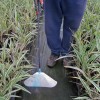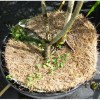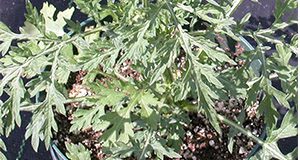This six-page fact sheet provides an overview of Ragweed Parthenium, Parthenium hysterophorous L, including a species description and information on how to manage ragweed parthenium culturally, physically, and chemically. Written by Debalina Saha, Chris Marble, Robert H. Stamps, and Shawn Steed and published by the Environmental Horticulture Department.
http://edis.ifas.ufl.edu/ep531
Tag: Robert H. Stamps
Uso Apropiado y Manipulacion de Glifosato en Viveros de Plantas (ENH1209/EP470)
 El glifosato es el químico de protección para cultivos más vendido en el mundo y el herbicida mós usado en la industria de viveros de plantas en los Estados Unidos. El glifosato es usado para el control post emergente de malezas. Esta publicación describe el uso adecuado de glifosato para los productores de plantas y sus empleados. This 4-page fact sheet was written by Shawn T. Steed, Robert H. Stamps, and Rodrigo Diaz, and published by the UF Department of Environmental Horticulture, February 2013.
El glifosato es el químico de protección para cultivos más vendido en el mundo y el herbicida mós usado en la industria de viveros de plantas en los Estados Unidos. El glifosato es usado para el control post emergente de malezas. Esta publicación describe el uso adecuado de glifosato para los productores de plantas y sus empleados. This 4-page fact sheet was written by Shawn T. Steed, Robert H. Stamps, and Rodrigo Diaz, and published by the UF Department of Environmental Horticulture, February 2013.
http://edis.ifas.ufl.edu/ep470
Alternatives to Synthetic Herbicides for Weed Management in Container Nurseries (ENH1203/EP464)
 Weed management is one of the most critical and costly aspects of container nursery production. This is most effectively achieved through preventative practices, primarily with preemergent herbicides. But there are valid reasons for managing weeds with alternatives to synthetic herbicides, including sanitation, exclusion, prevention, hand weeding, mulching, and the use of cover crops, heat, and nonsynthetic herbicides. This 6-page fact sheet was written by Gary W. Knox, Matthew Chappell, and Robert H. Stamps, and published by the UF Department of Environmental Horticulture, September 2012.
Weed management is one of the most critical and costly aspects of container nursery production. This is most effectively achieved through preventative practices, primarily with preemergent herbicides. But there are valid reasons for managing weeds with alternatives to synthetic herbicides, including sanitation, exclusion, prevention, hand weeding, mulching, and the use of cover crops, heat, and nonsynthetic herbicides. This 6-page fact sheet was written by Gary W. Knox, Matthew Chappell, and Robert H. Stamps, and published by the UF Department of Environmental Horticulture, September 2012.
http://edis.ifas.ufl.edu/ep464
Proper Use and Handling of Glyphosate in Plant Nurseries (ENH1198/EP459)
 Glyphosate is the most used herbicide in the nursery industry in the United States. Used for postemergent control of vegetation, it controls annual and perennial grasses, broadleaves, and sedges. But it is easy to cause unintended damage to desirable vegetation if this product is used incorrectly. This 4-page fact sheet outlines the proper use of glyphosate for plant producers and their employees. Written by Shawn T. Steed and Robert H. Stamps and published by the UF Department of Environmental Horticulture, May 2012.
Glyphosate is the most used herbicide in the nursery industry in the United States. Used for postemergent control of vegetation, it controls annual and perennial grasses, broadleaves, and sedges. But it is easy to cause unintended damage to desirable vegetation if this product is used incorrectly. This 4-page fact sheet outlines the proper use of glyphosate for plant producers and their employees. Written by Shawn T. Steed and Robert H. Stamps and published by the UF Department of Environmental Horticulture, May 2012.
http://edis.ifas.ufl.edu/ep459
Preemergence Herbicides for Use in Ornamentals (OH94/WG058)
 Preemergence herbicides are herbicides that are applied prior to weed seed germination. Control of weeds using preemergence herbicides is most successful when the correct herbicide is applied in the correct manner to a weed-free growing medium prior to weed seed germination. This 60-page fact sheet was written by Robert H. Stamps, Heidi M. Savage, Diane K. Rock, and Jeffrey G. Norcini, and published by the UF Department of Environmental Horticulture, March 2012.
Preemergence herbicides are herbicides that are applied prior to weed seed germination. Control of weeds using preemergence herbicides is most successful when the correct herbicide is applied in the correct manner to a weed-free growing medium prior to weed seed germination. This 60-page fact sheet was written by Robert H. Stamps, Heidi M. Savage, Diane K. Rock, and Jeffrey G. Norcini, and published by the UF Department of Environmental Horticulture, March 2012.
http://edis.ifas.ufl.edu/wg058
Identification, Impacts, and Control of Ragweed Parthenium (Parthenium hysterophorus L.) (ENH1187/EP448)
 One of the worlds most invasive weeds, this member of the Asteraceae family is a problem in Africa, Australia, India, and is increasingly a problem in Florida. Learn more in this 10-page fact sheet was written by Robert H. Stamps, and published by the UF Department of Environmental Horticulture, December 2011.
One of the worlds most invasive weeds, this member of the Asteraceae family is a problem in Africa, Australia, India, and is increasingly a problem in Florida. Learn more in this 10-page fact sheet was written by Robert H. Stamps, and published by the UF Department of Environmental Horticulture, December 2011.
http://edis.ifas.ufl.edu/ep448
Prevention, Early Detection, and Eradication of Benghal Dayflower in Field Nurseries (ENH1085/EP350)
Benghal dayflower is an increasingly problematic weed that is federally designated as a noxious weed. This 10-page fact sheet provides nursery owners how to prevent, detect, and eradicate this invasive plant. Written by Robert Stamps, and published by the UF Department of Environmental Horticulture, May 2011.
http://edis.ifas.ufl.edu/ep350
ENH1168/EP429 Cold Protection of Foliage Plants in Shadehouses and Greenhouses
ENH1168, a 10-page illustrated fact sheet by Robert H. Stamps, Jianjun Chen, Seenivasan Natarajan, and Lawrence R. Parsons, informs ornamental foliage plant growers about various cold protection measures that can be adopted before and during cold events to avoid or minimize losses due to chilling or cold injury. Includes glossary and references. Published by the UF Department of Environmental Horticulture, July 2010.
http://edis.ifas.ufl.edu/ep429
ENH1118/EP383 Selected Miticides for Use on Ornamental Plants
ENH1118, an 11-page fact sheet by Robert H. Stamps and Lance S. Osborne, provides an overview of the main mite pests of ornamental plants, detection and control. Includes references and tables listing miticides and manufacturers/distributors. Published by the UF Department of Environmental Horticulture, April 2009.
http://edis.ifas.ufl.edu/EP383
ENH1085/EP350 Some Suggestions for Controlling Benghal Dayflower in Field Nurseries
ENH-1085, a 9-page illustrated fact-sheet by Robert Stamps, describes this increasingly problematic weed — also known as jio, tropical spiderwort, hairy wandering jew, and Indian dayflower — in field nurseries, its identification, control, factors effecting pre- and post-emergence herbicides, tables of recommended herbicides, and references. Published by UF Department of Environmental Horticulture, January 2008.
http://edis.ifas.ufl.edu/EP350
